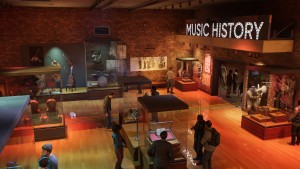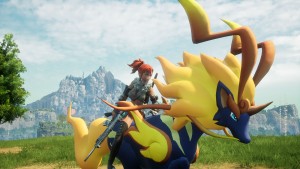Wilson's Heart Review

Looking back at the early horror films like Frankenstein, Creature from the Black Lagoon, and Dracula, they stand out more for their nascent filmmaking techniques than they do for providing scares. Undoubtedly innovators at the time, the rudimentary special effects, antediluvian direction, and melodramatic scores have not aged well. Perhaps it’s fitting that Twisted Pixel tapped this same aesthetic for its first virtual reality game. Like those early attempts at cinematic horror, decades down the line gamers examining early VR experiences like Wilson’s Heart may have a tough time seeing past the limited and clunky mechanics.
Set in the 1940s, Wilson’s Heart puts players in the body of a grizzled war veteran who awakens shackled to a chair in a hospital and wearing a surgery gown. Unattended and surrounded by empty beds, he breaks his restraints and wanders the halls looking for help. Wilson quickly realizes something is amiss. Large sections of the hospital walls have crumbled, his heart has been replaced by a strange orb that appears to run on occult magic, and a killer teddy bear is murdering nurses. Teaming up with a mysterious group of survivors trapped in the hospital, Wilson explores the facility to track down his missing heart and find the origin of this supernatural outbreak.
Wilson’s Heart’s bursts at the seams with many classic horror themes, but don’t expect it to make you jump out of your Rift headset. Rather than fill the hospital with a suffocating sense of dread and pulse-skipping jump scares, Twisted Pixel employs the macabre camp of classic films. The black-and-white presentation allows the developer to play with lighting and shadow to set the spooky mood of each scene, and tension pervades much of the exploration, but most of the frights feel telegraphed.
This “see-and-click” adventure plays much like the point-and-click games of the genre’s past. While surveying the environment, ghost-like silhouettes of Wilson appear at points of interest. With no natural locomotion mechanic present, players navigate by jumping from position to position. The screen momentarily blacks out as Wilson makes the journey to the new position, which pulls you out of the sense of being present. All VR developers are still struggling to get past this glaring limitation, but at least this node-based movement system is low-impact. I played the game for hours at a time with no sense of simulation sickness and didn’t leave sessions with that VR nausea hangover I’ve experienced with other games.
The quest to find Wilson’s heart takes you to many creepy corners of the hospital, from the padded rooms of the asylum wing to an unsettling room of early prosthetics. Each environment presents a light puzzle for you to solve before proceeding. Many of these involve turnkey solutions you simply need to discover by interacting with the limited number of objects available or using Wilson’s strange heart device that can pop out of his chest. One configuration allows him to pull items toward him, and another activates light sources to keep away the lurking dangers in the darkness. When you move slightly out of the position the game expects you to stand in – to open another desk drawer, for example – you are awkwardly pulled out of Wilson’s body, or faced with the boundary lines that normally keep you within your designated play space. These boundaries don’t reflect your true roomscale play space, limiting you to a much smaller area to roam, and the frequent interruptions abruptly pull you out of the moment, killing the otherwise spooky atmosphere.
The limited interactivity is compounded by the minimalist inventory system. Rather than let you keep potentially useful items after you have used them for their intended purpose (I would prefer to hold onto this machete thank you very much – there are monsters wandering these halls), you can only keep them if the game deems it necessary for another puzzle. This means there is only one way to solve these puzzles, which severely limits player creativity. This lack of freedom extends into combat as well.

To break up the monotony of poking around the hospital, Wilson’s Heart marches out a who’s who cast of classic film monsters to fight, including a fly man, an undead soldier, amphibious humanoids, and a reanimated scientific monstrosity. Players engage in these battles from a stationary position, so you can’t simply dodge attacks. Instead, each skirmish expects you to follow its specific rules of engagement, from what weapon you use to how you land the killing blow. Sometimes all you can do is block and punch, but you unlock new configurations of Wilson’s mechanical heart as you progress. One setting lets you electrocute nearby enemies by throwing the orb into a pool of water, while another acts as a boomerang that can kill any ghouls in its flight path. The motion sensors don’t always register your movements, so expect to frustratingly replay some of these encounters until you figure out the most surefire way to get those throws to work correctly.
Between exploration and combat, Wilson occasionally reunites with the other survivors in the building. Twisted Pixel hired an all-star cast to bring these eccentric characters to life, signing the likes of Rosario Dawson (Death Proof, Daredevil) and Michael B. Jordan (Chronicle, Creed). Mr. Robocop himself, Peter Weller, stars as Wilson, and his gruff, deadpan delivery suits the camp vibe. The exaggerated art style and wooden movements make them seem like mannequins brought to life, but Twisted Pixel added some clever touches like having their eyes track yours as they speak to you. These encounters are fleeting, but players can learn more about the curious characters’ backstories by finding comic books and newspapers throughout the hospital.
Wilson’s Heart gets a lot of things right. The spooky atmosphere, charming camp, and long-form narrative are great proofs of concept for virtual reality adventures. Considering most VR titles available right now feel more like glorified tech demos than full-fledged games, I enjoyed the extended sessions of this six-to-eight-hour experience. But Wilson’s Heart’s limited interactivity, lack of freedom, and wooden combat show developers still have a lot to learn about creating truly immersive virtual reality experiences.










